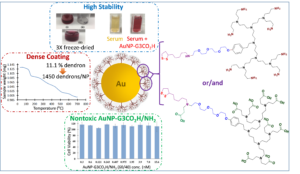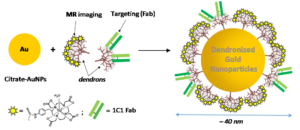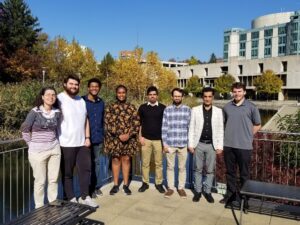 |
|
Contact Information
Office: MEYR 405A
Phone: 410-455-5601
Email: mdaniel@umbc.edu
|
Associate Professor
Professional Interests
The Daniel lab’s research revolves around the preparation of multifunctional colloidal inorganic nanoparticles for either medical, materials or environmental applications.
The group has developed a highly stable, zwitterionic dendronized gold nanoparticle (AuNP)-based drug delivery platform, specifically for use in chemotherapeutics delivery. This nanocarrier platform enables very high payload since it can hold up to 1450 dendrons/NP. The highly dense and mixed coating on the AuNPs allows for the controlled combination of optimum payloads of drugs and targeting/imaging agents on a single platform.
Daniel’s group is also preparing AuNPs of various shapes (spheres, rods, bipyramids) with specific coatings to direct the formation of discrete assemblies with quantum dots (QDs) for use as novel optical modulators for quantum computing. Some of our recent data have led to the first definitive evidence of strong coupling between a single emitter and a gap plasmon in a system composed of a single CdSe/CdS QD between a gold nanosphere and a silver film.
Finally, we are also developing microfluidic sensors for the detection of lead in tap water. It is based on nanoparticles aggregation in the presence of very low amount of lead, leading to a change of color of the nanoparticle solution.
Selected Publications
- Hayashi, A. F.; Campeiro, J. D. A; Carvalho Porta, L: Szychowski, B.; Alves, W.; Oliveira, E. B.; Kerkis, I.; Daniel, M.-C.; Karpel, R. L. “Crotamine: A Novel Cell-Penetrating Polypeptide Nanocarrier with Potential Biotechnological Applications, and Effects on Animal Metabolism and against Cancer” In: Nanoparticles in Biology and Medicine: Methods and Protocols, Methods in Molecular Biology, Volume 28 of Nanoparticles in Biology and Medicine. Second Edition, Mikhail Soloviev (ed.), Springer, 2019.
- Dockery, L; Daniel M-C. “Dendronized Systems for the Delivery of Chemotherapeutics” In: Cancer Nanotechnology, Volume 139 of Advances in Cancer Research book series, 1st Edition, Ann-Marie Broome (Serial Volume Editor), Elsevier, 2018, 85-114.
- Daniel, M-C. “Drug delivery carriers.” In: Emerging Applications of Colloidal Noble Metals in Cancer Nanomedicine. Lakowicz JR, Zhang J (Eds). Future Medicine, London, UK, 2012, 54–67.
- Gu, Q., Dockery, L., Onuta, M.-C., Bieberich, C. J., Ma, R., Zhu, L. Nanoparticle Delivery in Prostate Tumors Implanted in Mice Facilitated by Either Local or Whole-Body Heating. Fluids 2021 6, 272(1-17).
- Gu, Q.; Liu, S.; Saha Ray, A.; Florinas, S.; Christie, R. J.; Daniel, M.-C.; Bieberich, C.; Ma, R.; Zhu, L. Mild Whole-Body Hyperthermia-Induced Interstitial Fluid Pressure Reduction and Enhanced Nanoparticle Delivery to PC3 Tumors: In Vivo Studies and Micro-Computed Tomography Analyses. Thermal Sci. Eng. Appl. 2020, Published Online: February 28, 2020.
- Saha Ray, A.; Ghann, W.E.; Tsoi, P.; Szychowski, B.; Dockery, L.; Pak, Y.; Li, W.; Kane, M.; Swaan, P.; Daniel, M.C. Set of Highly Stable Amine- and Carboxylate-terminated Dendronized Au Nanoparticles with Dense Coating and Nontoxic Mixed-dendronized Form. Langmuir 2019, 35 (9), pp 3391–3403.
- Hansen, M.; Truong, J.; Szychowski, B.; Xie, T.; Daniel, M. C.; Hahm, J. I., Single Nanomaterial Level Investigation of ZnO Nanorod Sulfidation Reaction via Position Resolved Confocal Raman Spectroscopy. Nanoscale 2019, 11, 1147-1158.
- Leng, H.; Szychowski, B.; Daniel, M.-C.; Pelton, M. Strong Coupling and Transparency at Room Temperature with Single Quantum Dots and Gap Plasmons. Nature Communications 2018, 9:4012, DOI: 1038/s41467-018-06450-4.
- Szychowski, B.; Leng, H.; Pelton, M.; Daniel, M. C., Controlled etching and tapering of Au nanorods using cysteamine. Nanoscale 2018, 10 (35), 16830-16838.
- Karpel, R. L.; da Silva Liberato, M.; Campeiro, J. D.; Bergeon, L.; Szychowski, B.; Butler, A.; Marino, G.; Cusic, J. F.; de Oliveira, L. C. G.; Oliveira, E. B.; de Farias, M. A.; Portugal, R. V.; Alves, W. A.; Daniel, M. C.; Hayashi, M. A. F., Design and Characterization of Crotamine-functionalized Gold Nanoparticles. Colloids Surf B Biointerfaces 2018, 163, 1-8.
- Truong, J.; Hansen, M.; Szychowski, B.; Xie, T.; Daniel, M. C.; Hahm, J. I., Spatially Correlated, Single Nanomaterial-Level Structural and Optical Profiling of Cu-Doped ZnO Nanorods Synthesized via Multifunctional Silicides. Nanomaterials (Basel) 2018, 8 (4), 222.
- Leng, H.; Szychowski, B.; Daniel, M. C.; Pelton, M., Dramatic Modification of Coupled-Plasmon Resonances Following Exposure to Electron Beams. J Phys Chem Lett 2017, 8 (15), 3607-3612.
- Allec, N.; Choi, M.; Yesupriya, N.; Szychowski, B.; White, M.; Kann, M.; Garcin, E.; Daniel, M.-C.; Badano, A. “Small-angle X-ray scattering method to characterize molecular interactions: Proof of concept” Scientific Reports, 2015; 5: 12085.
- Pan, H.; Grow, M. E. Wilson, O. M. and Daniel, M.-C. “A New PPI Dendron as Potential Convenient Building-block in Construction of Multifunctional Systems for Biomedical Applications” Tetrahedron, 2013, 69, 2799-2806.
- Zabetakis, K.; Ghann, W. E.; Kumar, S.; Daniel, M.-C. “Effect of high gold salt concentrations on the size and polydispersity of gold nanoparticles prepared by an extended Turkevich-Frens method” Gold Bulletin, 2012, 45(4), 203-211.
- Ghann, W. E.; Aras, O.; Fleiter, T.; Daniel M.-C. “Syntheses and Characterization of Lisinopril-Coated Gold Nanoparticles as Highly Stable Targeted CT Contrast Agents in Cardiovascular Diseases” Langmuir, 2012, 28(28), 10398-10408.
- Daniel, M.-C.; Grow, M. E.; Pan, H.; Bednarek, M.; Ghann, W. E.; Zabetakis, K.; Cornish, J. “Gold nanoparticle-cored Poly(propyleneimine) Dendrimers as New Platform for Multifunctional Drug Delivery Systems” New Journal of Chemistry, 2011, 35(10), 2366-2374. (top ten accessed articles from the online version in Sept. 2011)
- Ghann, W. E.; Aras, O.; Fleiter, T.; Daniel, M.-C. “Synthesis and biological studies of highly concentrated lisinopril-capped gold nanoparticles for CT tracking of angiotensin converting enzyme (ACE)” Proc. SPIE 2011, 8025, 80250H.
- Pan, H.; Daniel, M.-C. “Studies of MRI relaxivities of gadolinium-labeled dendrons” Proc. SPIE 2011, 8025, 80250F.
- Pan, H.; Daniel, M.-C. “Gadolinium-labeled dendronized gold nanoparticles as new targeted MRI contrast agent” Proc. SPIE 2010, Vol. 7674(Smart Biomedical and Physiological Sensor Technology VII), 767404/1-767404/10.
- Daniel, M.-C.; Aras, O.; Smith, M. F.; Nan, A.; Fleiter, T.; “Targeted in-vivo computed tomography (CT) imaging of tissue ACE using concentrated lisinopril-capped gold nanoparticle solutions” Proc. SPIE 2010, Vol. 7674(Smart Biomedical and Physiological Sensor Technology VII), 76740J/1-76740J/9
- Li, Y.; Baeta, C.; Aras, O.; Daniel, M.-C. “Preparation of lisinopril-capped gold nanoparticles for molecular imaging of angiotensin-converting enzyme” Proc. SPIE 2009, Vol. 7313, 731304
Funding
High-intensity focused ultrasound (HIFU) energized functionalized nanoparticles mediated enhanced thermal ablation of tumors
NSF (CBET)
06/01/21 – 05/01/24
PI: Dr. Banerjee (Mechanical Engineering, University of Cincinnati)
Assemblies of Metal Nanoparticles and Single Quantum Dots with Low-Power, Ultrafast Nonlinear Optical Response
NSF (EPM)
08/01/19 – 07/31/22
Other PI: Dr. Pelton (Physics, UMBC)
Understanding the Impact on Function of Interactions in Highly Multifunctional and Modular Nanocarriers
NSF (CHE)
08/15/15 – 07/31/18
Research Projects
Multifunctional nanocarriers for cancer chemotherapy
 Our new type of nanocarriers is based on a unique modular platform designed to integrate every characteristic of an ideal drug delivery system. This novel platform possesses two main advantages over already existing delivery systems. First, its design supports the creation of an all-in-one delivery system, displaying active targeting and imaging capabilities, as well as releasing a very large payload (up to several thousands of drugs) of several types of therapeutics simultaneously and in a controlled manner. Second, this platform endows the nanocarriers with great versatility, so that they can be easily adapted for use in the treatment of a variety of diseases.
Our new type of nanocarriers is based on a unique modular platform designed to integrate every characteristic of an ideal drug delivery system. This novel platform possesses two main advantages over already existing delivery systems. First, its design supports the creation of an all-in-one delivery system, displaying active targeting and imaging capabilities, as well as releasing a very large payload (up to several thousands of drugs) of several types of therapeutics simultaneously and in a controlled manner. Second, this platform endows the nanocarriers with great versatility, so that they can be easily adapted for use in the treatment of a variety of diseases.
Cancer chemotherapy represents the main area in which these drug nanocarriers are expected to have a tremendous effect. By dramatically reducing side effects and optimizing the therapeutic effect of drugs, they should ideally lead to the potential eradication of many challenging cancers. Consequently, the projects in my group concern multifunctional nanocarriers for cancer chemotherapy, in particular for pancreatic cancer and for hormone-refractory prostate cancer. These two types of cancer are considered very aggressive, and to date, incurable.
Specifically, our group has designed a highly stable, dendronized gold nanoparticle (AuNP)-based drug delivery platform, using a novel poly(propyleneimine) (PPI) dendron. The prepared dendronized AuNPs are able to withstand several rounds of lyophilization cycles with no sign of aggregation, are stable in  phosphate-buffered saline and Hanks’ buffer as well as in serum, and are resistant to degradation by glutathione exchange reactions. This nanocarrier platform displays a dense coating, with >1400 dendrons/AuNPs, which will enable very high payload.. Furthermore, while amine-terminated AuNPs expectedly showed cytotoxicity against the MCF-7 breast cancer cell line from a NP concentration of 1 nM, the mixed monolayer AuNPs (coated with 40/60 amine/carboxylate dendrons) interestingly did not exhibit any sign of toxicity at concentrations as high as 15 nM, similar to the carboxylate-terminated AuNPs. These dendronized AuNPs address the current practical need for a stable NP-based drug delivery platform which is scalable and easily conjugable, has long-term stability in solution, and can be conveniently formulated as a powder and redispersed in desired buffer or serum.
phosphate-buffered saline and Hanks’ buffer as well as in serum, and are resistant to degradation by glutathione exchange reactions. This nanocarrier platform displays a dense coating, with >1400 dendrons/AuNPs, which will enable very high payload.. Furthermore, while amine-terminated AuNPs expectedly showed cytotoxicity against the MCF-7 breast cancer cell line from a NP concentration of 1 nM, the mixed monolayer AuNPs (coated with 40/60 amine/carboxylate dendrons) interestingly did not exhibit any sign of toxicity at concentrations as high as 15 nM, similar to the carboxylate-terminated AuNPs. These dendronized AuNPs address the current practical need for a stable NP-based drug delivery platform which is scalable and easily conjugable, has long-term stability in solution, and can be conveniently formulated as a powder and redispersed in desired buffer or serum.
Our exciting preliminary results should lead to the development of a variety of multifunctional drug nanocarriers, in particular combining several types of chemotherapeutic drugs on the same system. This concept of combination chemotherapy with control over drug ratios is believed to be a promising avenue by a growing number of researchers in the field.
Hyperthermia for enhanced delivery of nanoparticles to tumors
Advancements in nanotechnology have revolutionized cancer treatment by conjugating therapeutic drugs onto nanocarriers for targeted delivery into tumors while reducing systemic toxicity. However, successful nanostructure transport from tumor capillaries to tumor interstitial space and diffusion to the entire tumor  region are still difficult to achieve, largely due to the large flow resistance caused by small pores in the capillary and high interstitial pressure in tumors. Previous studies have strongly suggested that hyperthermia would be a viable approach to overcome these two barriers. In this funded NSF grand, we have performed in vivo experimental studies to evaluate the effects of whole body and local mild hyperthermia on the deposition of nanoparticles in prostate tumors implanted in mice, and to measure body and tumor temperatures, tumor interstitial pressure, and local blood perfusion rates during experiments. MicroCT imaging was used to scan all the tumors resected after the experiments to determine both the 3-D nanoparticle distribution and the total amount of nanoparticle deposition in tumors.
region are still difficult to achieve, largely due to the large flow resistance caused by small pores in the capillary and high interstitial pressure in tumors. Previous studies have strongly suggested that hyperthermia would be a viable approach to overcome these two barriers. In this funded NSF grand, we have performed in vivo experimental studies to evaluate the effects of whole body and local mild hyperthermia on the deposition of nanoparticles in prostate tumors implanted in mice, and to measure body and tumor temperatures, tumor interstitial pressure, and local blood perfusion rates during experiments. MicroCT imaging was used to scan all the tumors resected after the experiments to determine both the 3-D nanoparticle distribution and the total amount of nanoparticle deposition in tumors.
Finally, we developed a comprehensive theoretical model to quantify nanoparticle transport across tumor capillaries and nanoparticle diffusion in the tumor interstitial tissue space, using experimentally measured parameters as inputs. These results, obtained by scan images, experimental data, and theoretical simulations, suggest mild whole body hyperthermia as a practical approach for overcoming transport barriers of nanoparticle delivery in prostatic prostate tumors.
This project has provided insights in understanding the effects of local and whole body hyperthermia on modifying the tumor porous structures of tumors and on activating physiological responses, leading to more nanoparticle deposition in tumors. MicroCT scans of nanoparticle distribution in prostate tumor demonstrated improved overall nanoparticle delivery to prostate tumor, and in particular an enhanced nanoparticle delivery to the tumor core region after a mild whole body hyperthermia. Experimental measurements of tumor interstitial fluid pressure and local blood perfusion rates before and after whole body hyperthermia provide experimental evidence of underlying physiological mechanisms leading to more nanoparticle deposition in tumors after an intravenous nanofluid injection. The theoretical simulations of nanoparticle transport across tumor capillaries and diffusion and advection in tumor interstitial space suggest possible increases in tumor permeability and improvement in lymphatic drainage as the transport mechanisms in the whole body hyperthermia process. It is envisioned that the collected experimental first-hand quantitative imaging data of nanoparticle distribution patterns can also be used to test assumptions and simplifications in future multi-scale modeling, to extract transport properties, and to ultimately advance understanding of nanoparticle transport in tumors with heterogeneous structures. In addition to enhancing nanoparticle delivery to tumors via mild whole body hyperthermia, the results of the project may be extended to other applications including nanotoxicology and targeted tissue ablation using nanoparticles as energy absorber.
High-intensity focused ultrasound (HIFU) energized functionalized nanoparticle-mediated enhanced thermal ablation of tumors
Nanoparticles (NPs)-mediated high intensity focused ultrasound (HIFU) is a minimally invasive surgical technique with significant potential for improving thermal ablation of cancers, uterine fibroids, and other malignant tissues. The Banerjee lab’s recent work has shown that HIFU heat deposition within the targeted tumor area and irreversible tumor cell damage are considerably enhanced by directly injected AuNPs. This approach reduces the need for high levels of HIFU power and minimizes thermal damage in adjacent normal tissues. However, HIFU with NPs has yet to achieve full therapeutic potential. Limitations of direct NP injection include HIFU applications limited to superficial tumors and a limited tumor target area; thereby, concerns exist for tumor cell re-seeding and the possibility of poorly/unevenly distributed NP concentrations leading to sub-optimal heating profiles. There remains an urgent need for treating deep-seated tumors and potentially minimizing metastasis.
Recent preliminary work by our multidisciplinary team suggests that AuNPs can be functionalized with Fab fragments to target prostate tumors (generated from  the PC3 cell line). Therefore, we envision that this noninvasive approach will provide targeted focal energy deposition and effective pressure in deep-seated tumors, as well as lower cavitation threshold, for reduced sonication power. Critical to our premise is that effective protocols for the treatment of metastasis have remained elusive. Metastasis remains a leading cause of cancer deaths, yet most studies use focal HIFU protocols for treating and evaluating localized prostate cancer. Our preliminary work using antibody-coated quantum dots demonstrated that injection of these particles into the mouse tail vein could selectively target receptors present on xenografts (generated from the HPET cancer stem cell line [derived from a high grade human prostate cancer (PCa) biopsy specimen]) implanted under the kidney capsule. This approach provides proof-of-principle that blood-born particles can target deep-seated tumor tissue, and potentially metastasizing cells and/or metastatic lesions.
the PC3 cell line). Therefore, we envision that this noninvasive approach will provide targeted focal energy deposition and effective pressure in deep-seated tumors, as well as lower cavitation threshold, for reduced sonication power. Critical to our premise is that effective protocols for the treatment of metastasis have remained elusive. Metastasis remains a leading cause of cancer deaths, yet most studies use focal HIFU protocols for treating and evaluating localized prostate cancer. Our preliminary work using antibody-coated quantum dots demonstrated that injection of these particles into the mouse tail vein could selectively target receptors present on xenografts (generated from the HPET cancer stem cell line [derived from a high grade human prostate cancer (PCa) biopsy specimen]) implanted under the kidney capsule. This approach provides proof-of-principle that blood-born particles can target deep-seated tumor tissue, and potentially metastasizing cells and/or metastatic lesions.
Our long-term goal is to contribute toward the development of highly effective NPs-mediated HIFU ablation procedures and expand their range to include targeted imaging and treatment of both deep-seated tumors and metastatic sites. The overall objective is to achieve focused ablation at reduced HIFU power levels using functionalized NPs-enhanced energy deposition. The central hypothesis is that HIFU ablation using systemically introduced functionalized NPs will increase precision targeting of localized tumors and enable uniform heat deposition in the target area, allowing for large volumes of cell necrosis at relatively low powers. Furthermore, it could facilitate targeting of metastasizing PCa cells and/or lesions.
Controlled Assembly of Inorganic Nanoparticles for the Formation of new Hybrid Nanomaterials
The goal of this collaborative project between the Pelton and Daniel research groups is to couple metal nanoparticles to semiconductor nanoparticles to modify the properties of the individual component particles. The coupling of nanoparticles has been used to enhance scattering, fluorescence, and absorption, leading  to applications in sensing, photocatalysis, and light harvesting. However, the exact properties that emerge are highly dependent on the precise arrangement and number of the coupled nanoparticles, and creating uniform, discrete assemblies remains a challenge. In particular, the coupling of plasmonic and excitonic nanoparticles has untapped potential if strong coupling between their respective plasmons and excitons can be reliably achieved. Novel properties, for example Fano interference and Rabi splitting, are expected to arise when these particles are strongly coupled. But coupling strength is especially dependent on the precise position of the component particles. Nevertheless, a system composed of a single emitter quantum dot strongly coupled to plasmonic nanoparticles would have widespread applications in photonics, optics, and information processing, making such a system desirable.
to applications in sensing, photocatalysis, and light harvesting. However, the exact properties that emerge are highly dependent on the precise arrangement and number of the coupled nanoparticles, and creating uniform, discrete assemblies remains a challenge. In particular, the coupling of plasmonic and excitonic nanoparticles has untapped potential if strong coupling between their respective plasmons and excitons can be reliably achieved. Novel properties, for example Fano interference and Rabi splitting, are expected to arise when these particles are strongly coupled. But coupling strength is especially dependent on the precise position of the component particles. Nevertheless, a system composed of a single emitter quantum dot strongly coupled to plasmonic nanoparticles would have widespread applications in photonics, optics, and information processing, making such a system desirable.
To this end, Pelton and Daniel are investigating the assembly and optical properties of gold nanoparticles-CdSe/CdS quantum dots conjugates. The Daniel’s lab has linked excitonic nanoparticles (CdSe/CdS quantum dots) to gold nanoparticles through covalent bonds. Strong plasmon-exciton coupling was achieved between a single CdSe/CdS quantum dot and the gap plasmon formed between a gold nanosphere and a silver film, providing the first definitive evidence of strong coupling between a single emitter and a gap plasmon. This study revealed that the yield of strongly coupled particles was limited by the geometry of nanospheres. To address this, a method was developed to sharpen gold nanorods post-synthesis by etching them with cysteamine. The sharpened tips of these nanorods provide the local geometry that was observed to be necessary to obtain strong coupling. The Daniel’s lab has also recently started investigating the use of gold nanobipyramids for the linking of a single quantum dot at its tip. The work described here demonstrates the wide-ranging applications of inorganic nanoparticle assemblies, from bio-detection to photonics, and represents a major step towards the development of usable materials using strongly coupled plasmonic and excitonic nanoparticles.
